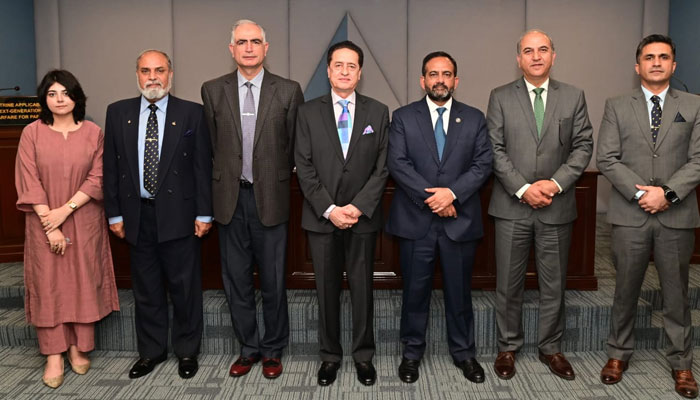CASS Seminar Explores Air Doctrine’s Role in Next-Generation Warfare for PAF
Lahore – The Centre for Aerospace & Security Studies (CASS) in Lahore hosted an insightful seminar titled “Air Doctrine: Applicability in Next-Generation Warfare for PAF” on February 25, 2025. The seminar brought together leading experts and strategists to discuss the evolving dynamics of aerial warfare, emerging technologies, and the strategic shifts required for the Pakistan Air Force (PAF) to remain effective in South Asia’s changing security landscape.
Dr. Air Commodore Naveed Khaliq Ansaree (Retd), Director at CASS, opened the seminar with introductory remarks, underscoring the critical importance of air doctrine in modern military strategies and its direct impact on the PAF’s future operational readiness.
Emerging Technologies in Warfare
Dr. Adil Sultan, Dean of the Faculty of Aerospace and Strategic Studies (FASS) at Air University Islamabad, delivered a compelling talk on “Impact of Emerging Technologies on Next-Generation Warfare.” He discussed the role of artificial intelligence, quantum computing, cyberspace, space systems, and AI-integrated drones in shaping future conflicts. Dr. Sultan also cautioned about the commercialization of space, highlighting the potential security risks it poses for future warfare.
Airpower Doctrine for the PAF
Air Marshal Abdul Moeed Khan (Retd), Vice Chancellor of Air University Islamabad, shared valuable insights on “Airpower Doctrine and Development Strategy for the PAF.” He explained that the PAF’s air doctrine is evolving to incorporate niche and disruptive technologies to offset numerical disadvantages, prioritize information superiority, and enhance operational flexibility. He highlighted critical developments in agile combat employment, decentralized execution, and the exploitation of the electromagnetic spectrum.
Doctrinal Shifts in South Asian Aerial Warfare
Air Vice Marshal Nasser ul Haq Wyne, Director of Aerospace & Warfare at CASS Islamabad, delivered a session on “Doctrinal Shift in Aerial Warfare in South Asia.” He addressed the Grey Zone conflict scenario, where India is pursuing a strategy of “No War, No Peace,” blending kinetic and non-kinetic tools while avoiding full-scale war. He also discussed how airpower has shifted from a supporting to a supported role in modern warfare. Key adaptations in the PAF included hybrid warfare integration, cyber and electronic warfare capabilities, investment in unmanned systems, and strategic partnerships.
Commitment to Evolving Air Doctrine
In his concluding remarks, Air Marshal Asim Suleiman (Retd), President of CASS Lahore, emphasized the PAF’s unwavering commitment to evolving its air doctrine in response to emerging threats. He noted the PAF’s focus on deterrence, precision engagement, and operational flexibility. He highlighted significant advancements in radar technology, beyond-visual-range (BVR) capabilities, electronic warfare, and multi-domain operations that have strengthened the PAF’s edge.
Air Marshal Suleiman further stressed that future warfare will heavily rely on artificial intelligence, cyber resilience, and space-based surveillance. Under the leadership of Air Chief Marshal Zaheer Ahmed Baber Sidhu, the PAF is committed to maintaining air superiority with cutting-edge technologies, world-class training, and innovative programs such as the National Aerospace Science and Technology Park (NASTP).
He added that, currently, the PAF holds a strategic advantage over the Indian Air Force (IAF) for at least six to seven years, thanks to its first-shot capability, the planned induction of fifth-generation aircraft, and advancements in multi-domain operations. However, he warned that this advantage could diminish if the IAF successfully inducts the F-35 and matches the PAF’s force multipliers and technological advancements. If the IAF fails to keep pace, the PAF will maintain its advantage for at least another decade.
Key Takeaways from the Seminar
The interactive session at the seminar sparked a lively discussion on the need for synergy between the three services to conduct multi-domain operations effectively. The speakers emphasized the importance of enhancing the PAF’s capacity to project power, especially in the Indian Ocean Region, and to be recognized as a potent force in future conflicts.
Overall, the seminar reinforced the importance of continuous modernization, strategic foresight, and technological innovation for the PAF to stay ahead in the evolving landscape of air warfare in South Asia.





Comments are closed, but trackbacks and pingbacks are open.